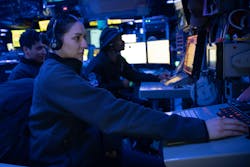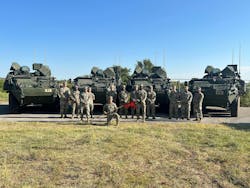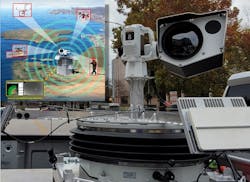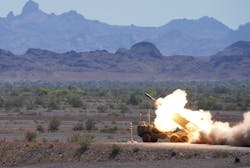Electro-optical sensors and signal processing merge for new capabilities
Summary points:
-
Integrated Electro-Optical and Directed Energy Systems: Modern electro-optical sensors are now part of complex, multi-domain systems that combine RF, embedded computing, and artificial intelligence to support rapid decision-making and real-time threat engagement. Technologies like the U.S. Army’s DE M-SHORAD and the Navy’s Layered Laser Defense (LLD) integrate high-energy lasers with advanced sensing for precision strikes and enhanced situational awareness.
-
Advanced Processing for Operational Superiority: High-speed embedded processing technologies—such as GPUs, FPGAs, and hybrid architectures—are crucial for handling the data-intensive requirements of adaptive optics, beam control, and sensor fusion. These processors enable real-time analysis in contested and extreme environments, supporting both lethal and sensing roles.
-
Sensor Fusion and DSP as Battlefield Force Multipliers: Digital signal processing is central to modern sensor fusion, allowing military systems to merge data from radar, lidar, infrared, RF, and SIGINT sources. This enables real-time threat detection, collaborative targeting by UAVs and loitering munitions, and AI-driven anomaly detection—providing warfighters with a comprehensive and dynamic picture of the battlespace.
NASHUA, N.H. - The modern battlefield is a sensing environment -- dense with signals, signatures, and data. Electro-optical sensors, once isolated tools for targeting and surveillance, have become part of tightly integrated systems that support rapid decision-making at the tactical edge. Their evolution and advanced digital signal processing (DSP), embedded computing, and radio frequency (RF) technologies enable warfighters to perceive, understand, and act faster than ever.
From mounted systems on fifth-generation jet fighters and autonomous drones, to wearable electro-optical devices in the hands of infantry, sensors are shrinking in size while growing in capability. Speed is paramount: today’s sensors not only must detect, but also process and interpret information in real time -- often autonomously or semi-autonomously -- amid increasing demands for resilience in denied or contested environments.
The convergence of electro-optical, RF, and embedded systems create systems that see more, process more, and support operations across air, land, sea, space, and cyber space. At the center of this transformation is a new generation of enabling technologies, ranging from high-energy lasers to artificial intelligence (AI)-focused processors.
Directed energy integration
Across the services, high-energy lasers are being fielded for applications ranging from short-range air defense and counter-UAS (CUAS) to precision target designation and active sensing. And as solid-state and fiber laser technologies improve, the size, weight, and power (SWaP) barriers that once limited deployment are quickly eroding.
In the directed energy domain, industry leaders integrate lasers with infrared sensors and advanced beam control systems to enable real-time target engagement with minimal collateral damage. For example, the U.S. Army’s Directed Energy Maneuver-Short Range Air Defense (DE M-SHORAD) program has already demonstrated a 50-kilowatt class laser system aboard a Stryker vehicle capable of engaging drones and incoming projectiles with precision and repeatability.
In March 2023, the Army conducted a live fire demonstration of the DE M-SHORAD prototypes at Yuma Proving Ground, Ariz. Soldiers from the 4-60th Air Defense Artillery Regiment (ADAR) worked with the DE M-SHORAD team to showcase the laser system’s potential.
"The delivery of DE M-SHORAD prototypes to the 4-60th ADAR represents a transformational milestone in the Army’s modernization campaign. It is an achievement that adds what was often thought of as a next generation capability, now," said Col. Steven D. Gutierrez from the DE M-SHORAD project management office. "These high energy laser systems will be a game-changer on the contemporary battlefield, a critical component of an integrated, layered, and in-depth air missile defense for division and brigade maneuver formations."
On the maritime side, the U.S. Navy’s Layered Laser Defense (LLD) prototype integrates electro-optical sensors with high-energy lasers for use on surface ships, offering both ISR and kinetic strike capabilities in a single system. These systems leverage real-time sensor fusion to identify and prioritize threats, directing laser energy with pinpoint accuracy and without relying on kinetic ammunition.
"Innovative laser systems like the LLD have the potential to redefine the future of naval combat operations," said then-Chief of Naval Research Rear Adm. Lorin C. Selby in 2022. "They present transformational capabilities to the fleet, address diverse threats, and provide precision engagements with a deep magazine to complement existing defensive systems and enhance sustained lethality in high-intensity conflict."
Computer challenges
Integrating laser systems into operational environments isn’t just about optics and power levels; it’s also a computing challenge. Beam control, thermal management, and adaptive optics all depend on high-speed embedded processing systems capable of handling enormous data volumes in real time. To meet these demands, developers are turning to ruggedized graphics processing units (GPUs), field-programmable gate arrays (FPGA), and hybrid processor architectures that can survive harsh battlefield conditions while maintaining low-latency performance.
Another growing trend is using lower-power lasers in sensing roles, particularly in lidar-based systems for mapping, target acquisition, and object recognition. These sensors are increasingly embedded in autonomous vehicles and loitering munitions, where precise depth perception and real-time scene analysis are critical to mission success.
Directed energy is becoming an essential component of layered defense architectures in both lethal and non-lethal roles. As laser technology matures, the integration of electro-optical sensors with high-speed signal processing and adaptive beamforming is pushing directed energy from the lab to the front lines -- changing not just how the military sees the battlefield but also how it shapes it.
Sensor fusion and DSP
In a contested battlespace, no single sensor can provide the complete picture. That’s why sensor fusion -- integrating data from multiple modalities like infrared, radar, lidar, and RF -- has become a cornerstone of modern military systems. At the heart of this fusion is digital signal processing (DSP), which enables the real-time analysis, correlation, and interpretation of vast streams of sensor data into actionable intelligence.
"New sensor fusion initiatives include cross-domain data fusion to integrate radar, IR, electro-optical, sonar, and SIGINT data for a comprehensive battlefield picture," says Rodger Hosking, director of sales at Mercury Systems in Andover, Mass. "Distributed sensing networks help swarm UAVs and smart sensor grids share real-time data for collaborative targeting. Automated anomaly detection exploits AI-assisted correlation of sensor feeds to detect hidden threats, like stealth aircraft and cyber intrusions.
He continues, "Sensor fusion imposes many technical and operational challenges. Sensors operate at different frequencies, resolutions, and bandwidths, often delivering diverse data formats, sampling rates, and coordinate systems because of the many different protocols across different military platforms and coalition forces.
"Real-time fusion of large-scale, high-dimensional sensor data requires high-performance computing. AI/ML models for fusion demand extensive training datasets and may be computationally expensive. Edge computing aboard UAVs/satellites is limited by power and processing constraints.
"Multiple sensors may provide contradictory data, and false alarms from one sensor can bias the entire fusion system. Accurate object association is difficult when tracking multiple entities across sensors with different fields of view. Sensor spoofing, such as GPS jamming or radar deception, can inject false data, and hacked or compromised sensors could provide misleading fusion results. Securing distributed sensor networks from cyber and electronic warfare attacks is critical," Hosking says.
As Hosking notes, today’s signal processors must do more than just simple filtering or amplification. They're performing multi-domain data fusion, applying complex algorithms for object detection, classification, and tracking -- all under extreme SWaP constraints. In airborne ISR platforms, for instance, fused electro-optical and synthetic aperture radar (SAR) feeds must be processed simultaneously to deliver high-confidence target information, even in poor visibility or electronically contested environments.
Emerging systems are going beyond traditional rule-based DSP and incorporating machine learning (ML) models that can adapt to evolving threat signatures. For example, deep learning algorithms trained on electro-optical and IR imagery can now distinguish between similar-looking targets, reducing false positives and enabling faster target prioritization. This is particularly critical in applications like C-UAS or missile warning, where seconds matter and operator overload is a constant concern.
DSP also plays a key role in spectral analysis and electronic warfare (EW). Military platforms are increasingly required to detect and characterize signals across wide RF bandwidths. Modern processors can sift through an enormous amount of RF and microwave signal data in real time, often autonomously identifying hostile emitters and enabling electronic attack or countermeasure deployment.
On the hardware side, advances in chip technology are bringing more processing power to the edge. Multi-core processors, high-throughput FPGAs, and system-on-chip (SoC) architectures are being ruggedized for deployment on small UAVs, handheld devices, and front-line vehicles. These platforms often use open standards like OpenVPX and Sensor Open Systems Architecture (SOSA) to streamline integration and maximize program reuse.
Sensor fusion isn’t just about connecting more sensors -- it’s about reducing the time from detection to decision. Engineers are now building systems where sensors feed directly into onboard DSP engines, which can trigger automated responses or flag human operators only when necessary. In an era of electronic clutter and peer adversaries with advanced jamming capabilities, this ability to rapidly filter signal from noise is essential.
Ultimately, it’s the processing -- not just the sensing -- that determines a system’s effectiveness. The integration of advanced DSP into multi-sensor architectures is allowing the military to detect threats sooner, react faster, and operate more confidently in an increasingly complex electromagnetic environment.
RF and microwave systems
While electro-optical sensors provide visual and thermal intelligence, RF and microwave systems offer range, speed, and penetration, making them essential in environments where visibility is limited or stealth is crucial. The integration of RF and electro-optical sensors enables defense systems to function across the entire electromagnetic spectrum, providing both redundancy and a more comprehensive operational picture.
Military platforms today are increasingly deploying wideband RF and microwave transceivers capable of operating across multiple frequency bands simultaneously. These systems support everything from radar and electronic warfare (EW) to communications and signals intelligence (SIGINT). When paired with electro-optical sensors and fast signal processing, they enable warfighters to correlate visual cues with RF signatures in real time -- enhancing target identification and reducing the risk of fratricide.
Microwave and millimeter-wave technologies are also integrated into next-generation fire control and ISR systems. High-frequency radar sensors are now compact enough to be mounted on small UAVs or man-portable devices, offering all-weather target detection and high-resolution mapping. The real challenge lies in managing the high data throughput these systems generate, necessitating fast, ruggedized processors that can operate at the tactical edge.
Open-systems standards are playing a key role in this integration. Architectures like CMOSS (C5ISR/EW Modular Open Suite of Standards) and SOSA help defense contractors align RF, electro-optical, and digital processing systems on a common hardware and software backbone. This not only speeds development and deployment but also improves system interoperability across platforms and services.
Additionally, the convergence of RF and electro-optical sensing drives innovation in electronic attack. Systems that once relied on pre-programmed jamming now dynamically adjust waveforms and beam patterns based on real-time sensor data. By using fused electro-optical and RF inputs, modern EW suites can detect threats, identify them by type, and tailor jamming or deception responses with surgical precision.
As adversaries invest heavily in anti-access/area-denial (A2/AD) systems and electromagnetic countermeasures, the U.S. and its allies are responding with sensors and systems that can operate across modalities and adapt on the fly. RF and microwave systems -- especially when integrated with electro-optical sensors and advanced signal processing -- are key to that response.
Embedded computing at the edge
Modern electro-optical and RF sensor suites generate torrents of data that must be processed in real time to be tactically useful. That’s driven a shift toward robust, edge-deployed computing architectures -- placing GPUs, FPGAs, and AI accelerators directly on platforms from UAVs to armored vehicles and soldier-worn systems. By moving processing as close as possible to the sensor, engineers reduce latency, minimize data links, and improve system resilience in contested or communications-denied environments.
Key to this trend are ruggedized, standards-based hardware modules. OpenVPX and SOSA-aligned backplanes provide the mechanical, electrical, and thermal infrastructure needed to integrate diverse processing elements -- whether it’s a high-throughput FPGA for real-time beamforming or a discrete GPU handling convolutional neural networks for target classification. These modules are designed to withstand extreme shock, vibration, and temperature swings, ensuring edge processors stay online during hard-use operations.
Software stacks and development frameworks have evolved in parallel. Containerized and virtualized environments allow field-programmable hardware and general-purpose CPUs to host multiple processing pipelines side by side -- enabling, for example, simultaneous electro-optical image enhancement, RF spectral analysis, and sensor-fusion algorithms on a single chassis. Real-time operating systems (RTOS) and hypervisors ensure that high-priority tasks like threat detection receive guaranteed CPU cycles, while less time-sensitive functions -- such as logging or remote system updates -- run in parallel.
Power and thermal management remain critical design considerations. Edge systems often run from mobile power sources or vehicular generators, where wattage is at a premium. Innovative cooling solutions—heat pipes, embedded liquid loops, and advanced thermal interface materials—help maintain optimal performance without adding excessive bulk. In many cases, adaptive power-scaling techniques throttle processor utilization dynamically based on mission phase, extending operational endurance without sacrificing critical processing capability.
By embedding powerful compute resources directly on the front line, defense engineers are ensuring that next-generation sensors don’t just see the battlespace -- they understand it. Edge computing transforms passive data collection into actionable intelligence, empowering warfighters with faster targeting, enhanced situational awareness, and autonomous decision support exactly where and when it’s needed.
Autonomy and AI target recognition
Autonomy is no longer limited to pilotless aircraft or self-navigating ground vehicles -- it’s becoming a defining feature of sensor systems themselves. At the heart of this transformation is AI and ML, which are enabling electro-optical, IR, and RF sensors to not only detect and track targets but to identify, classify, and even prioritize them with minimal human intervention.
The U.S. Department of Defense continues to push for greater autonomy at the tactical edge through programs like Joint All-Domain Command and Control (JADC2) and the Replicator initiative, both of which rely heavily on smart sensing technologies. These systems use embedded AI models trained on massive datasets to recognize patterns in real time—distinguishing between a commercial UAV and a hostile loitering munition, or between a civilian vehicle and a fast-moving armored threat.
In the infrared domain, neural networks are being deployed to perform tasks such as scene segmentation, facial recognition, and behavior analysis. This allows systems to flag unusual activity or detect concealed threats that human operators might overlook. These capabilities are particularly useful in urban warfare, perimeter defense, and force protection missions where visual clutter and rapid movement are the norm.
Autonomous target recognition also reshapes kinetic systems. Loitering munitions and autonomous strike platforms now leverage electro-optical and RF sensor data combined with onboard AI to identify and confirm targets before engagement. While human-in-the-loop protocols remain in place for lethal actions, the ability of a munition to navigate, search, and designate targets independently dramatically shortens the kill chain and reduces operator burden.
At the systems level, engineers are building sensor networks that learn and adapt. AI-driven signal processing engines can optimize sensor behavior based on mission context. Some systems even use reinforcement learning techniques to improve performance over time, learning from both successes and near-misses in live or simulated operations.
However, autonomy brings new challenges, particularly in validation, trust, and accountability. Ensuring that an AI system performs reliably under real-world conditions requires extensive testing and ongoing refinement, especially in mission-critical applications. That has led to a rise in hybrid systems, where AI handles initial processing and classification, but final decisions are deferred to human operators or supervisory control algorithms.
As AI algorithms become more capable and compact, and hardware accelerators continue to mature, autonomous sensor systems are moving from the lab to the field. Whether mounted on a drone, integrated into a helmet, or embedded in a missile, these systems give warfighters faster, more accurate information -- and in many cases, allow machines to act before humans even realize a threat exists.
Challenges and the road ahead
Despite rapid progress across electro-optical sensors, lasers, RF systems, and embedded processing, significant challenges remain in bringing fully integrated, real-time sensor systems to the warfighter. From data overload and SWaP constraints to cybersecurity and interoperability, engineers face a complex matrix of design and deployment hurdles as they push sensing and processing capabilities closer to the edge of combat operations.
One of the biggest technical challenges is managing the sheer volume of data generated by modern sensor suites. High-resolution electro-optical and IR imagery, wideband RF spectrum monitoring, and continuous signal processing generate terabytes of data in a single mission. Without advanced compression, filtering, and AI-driven prioritization, these data streams can overwhelm onboard processors and backhaul links, especially in bandwidth-constrained environments.
Interoperability is another critical concern. With services pursuing joint, all-domain operations, sensor systems must conform to open standards and communicate across platforms and networks not originally designed to work together. Initiatives like MOSA (Modular Open Systems Approach), SOSA, and CMOSS are helping, but legacy systems and platform-specific designs still create integration bottlenecks.
Security and resilience are equally pressing issues. electro-optical and RF sensors -- especially those linked to autonomous systems -- are becoming high-value targets for cyber and electronic attacks. Engineers must harden hardware and software against spoofing, jamming, and cyber intrusion, while ensuring mission-critical systems can still function under degraded or contested conditions.
Power and thermal limits continue to define the edge of what's possible. As more compute is pushed into smaller, more mobile platforms, managing power draw and heat dissipation without compromising performance or ruggedization is a key system-level design constraint. This is particularly true for AI-enabled sensors, which often require dedicated accelerators that draw significant power under load.
Looking ahead, the defense industry is focusing on convergence -- bringing electro-optical, RF, signal processing, AI, and communications into cohesive systems that operate faster and more autonomously. Future systems will be expected to detect and track a swarm of threats, synthesize data across domains, and either cue human operators or act independently in milliseconds. That will require not only technical innovation but deep coordination between sensor developers, embedded computing engineers, and military program managers.
Ultimately, the goal is clear: to give the warfighter better awareness, faster decision-making, and greater operational effectiveness. From low-earth orbit to ground combat, sensor processing technologies are at the center of modern warfare, and the future battlefield will belong to the force that can see, understand, and act the fastest.
About the Author

Jamie Whitney
Jamie Whitney joined the staff of Military & Aerospace Electronics and Intelligent Aerospace. He brings seven years of print newspaper experience to the aerospace and defense electronics industry.
Whitney oversees editorial content for the Intelligent Aerospace Website, as well as produce news and features for Military & Aerospace Electronics, attend industry events, produce Webcasts, oversee print production of Military & Aerospace Electronics, and expand the Intelligent Aerospace and Military & Aerospace Electronics franchises with new and innovative content.





